Non
Over Sampling modification (NOS)
february
2008
After looong delay
I finally tried the nos. Motivated by impatient friend, as usual.
He wanted a snipit mod plus NOS to squeeze the best sound for the buck
from his old but beautiful Marantz CD94-1.
I searched for tips and I found this nice help from DC audio web site:
http://www.dcaudio.kgb.pl/nos.htm
(also check his excellent list of CDM mechanisms:
http://www.dcaudio.kgb.pl/CDM.htm
Anyway, back to nos modification, it is a very simple process.
In case of TDA 1541 we just build a bypass of digital signal across the
chip that precedes the TDA and feeds it with the digital signal - we
cut away SAA7220p/B
What over sampling accomplishes is easier removal of sampling frequency
components from analogue signal.
In 44 kHz sampling rate, the 44 kHz square wave signal is "dangerously
close" to audible musical 20Hz-20KHz range. It is much easier to
filter the "noise" if the difference between the 20-20 and the noise
frequency is bigger than only twofold. That's when the clever engineers
decided to accelerate the clock on the square wave by 4 or 8 and in
this genius simple act - move the noise to completely inaudible range
above 100 kHz. The remaining artefacts are easy to filter in the
analogue
domain.
If we remove this process we bring the noise again to 44 kHz - so it
may be audible.
Well, I am not deaf, I am not 100 years old, and I do have one hell of
a tweeter - and let me tell you - listening with NON - oversampling -
there is NO PROBLEM AT ALL. At least
not with TDA1541.
After the mod - the music flows somehow easier, in a more liquid, more
natural fashion. It does not loose any of the good quality, none of the
power or attack of bass - everything becomes just a little bit better.
Don't expect miracles - I said a LITTLE BIT BETTER.
Highly recommended.
See
the Marantz mod description in detail.
April 9th.
Encouraged
by my first experience - I also modded the next player - the mighty
philips CD-880. It also has the usual trio of chips - 7210, 7220 and
1541A-\s1. I followed the instruction of DCAUDIO and the result was
really fantastic. The owner, who is a first class opera singer and
music lover - with his ears 100 times more trained than mine - just
loved the result of this 20 minute mod. Clearly - there is no debate -
no return to the over sampled mode. I agree.
But one thing worried me - the mute function got screwed up - there is
a small noise when changing tracks and the pause function results in CD
reading stopping in the chosen moment BUT THE music still flows. It is
like a 0,1 s portion of the track is played in a loop with full volume.
The CD mechanism reads just one full circle of the CD and does not
forward - but plays this circle audibly.
The recommended trick of bridge from leg 11 to leg 23 does not help. I
must further investigate this circuit. But even with this minor
inconvenience - the listening enjoyment is increased by a whole new
level.
The famous "veil" is removed, a thick veil that is.
May 2008 - I managed to NOS the
Marantz CD50 (same as CD40, CD60, and many many more)
This time I paid attention to
detail and the mute works properly.
Here
comes the instruction proven and tested following the DC AUDIO tips :
1. Locate the
"LEG 1" on the underside of 1541 and 7220 chips
2. on 7220
cut both traces as close as possible to legs 15 and 16
3. on 1541 cut
trace as close as pos on leg 1
4. using a thin
wire connect the 1541 and 7220 : leg 1 to 1, 2 to 2, and 3 to 3.
5. connect the
7220 leg 23 to the other chip - the de-modulator chip 7210 leg 11. In
case of the Marantz 40/50/60 - there is a newer chip - the 7310 - a
square black spider with 44 legs - 11 on each side of the square. The
mute is in this case leg 18 (which looks like floating)
6. sit back and listen.
In case of the SAA7220 and SAA7210 chips - if the mute trick does not
work, you must float (isolate) the leg 11 on SAA7210 before connecting
it to SAA7220P 's leg 23.
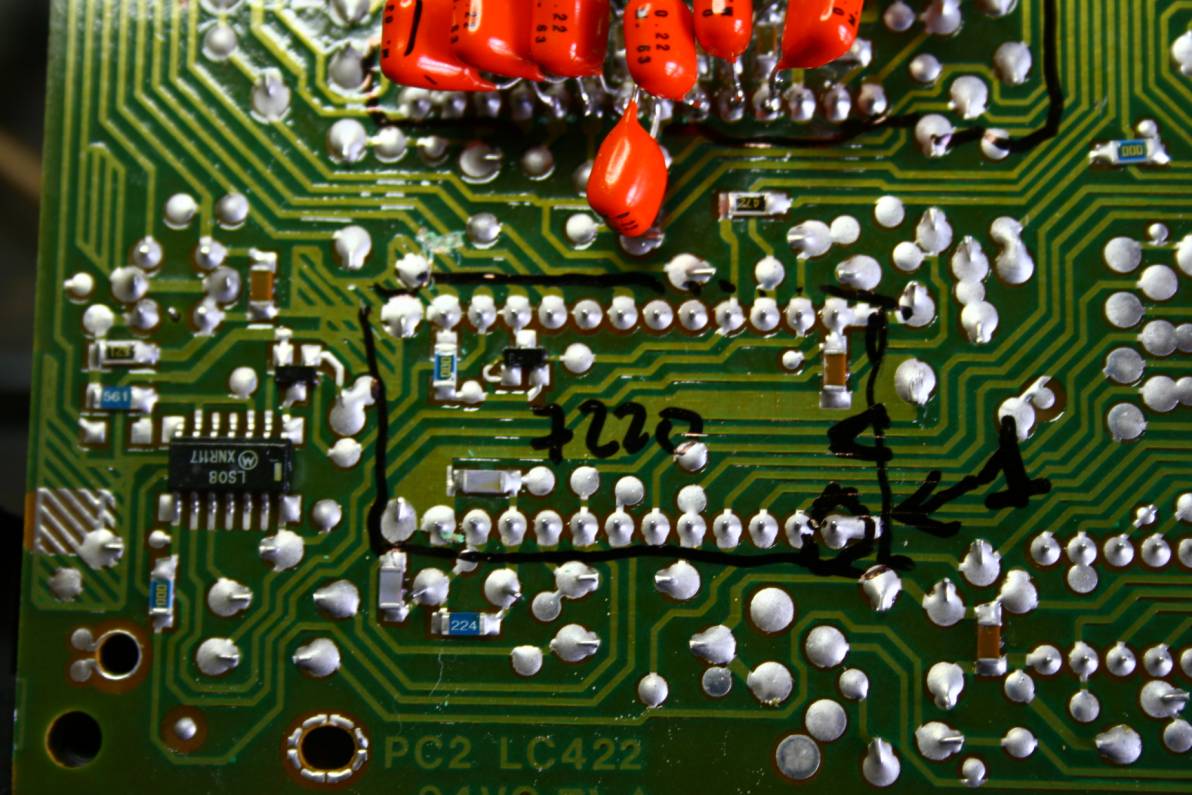
On the photo the chips are identified and their respective legs are
marked. Leg one is the one with arrow and circle. Note that the TDA1541
has new decoupling caps - the 14 orange ones above.
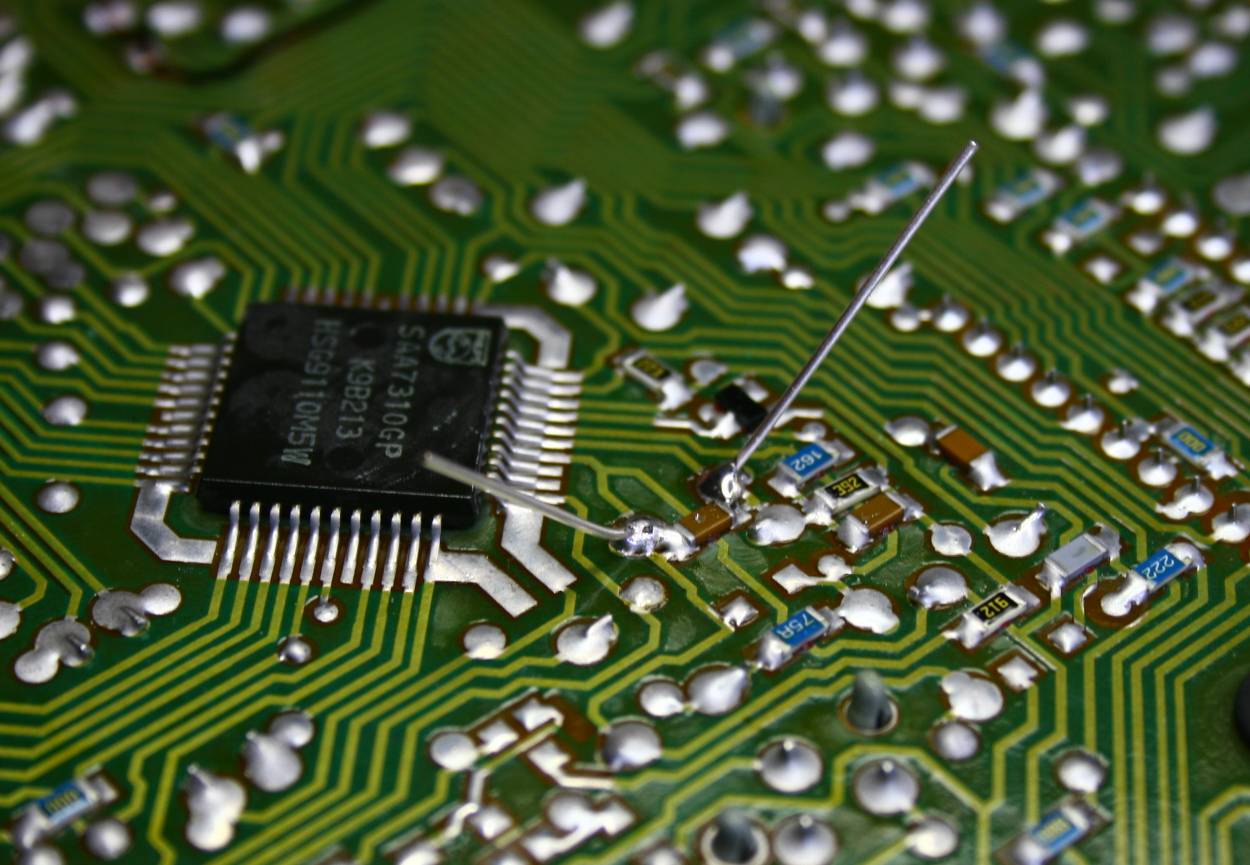
The demodulator receiver chip SAA7310 has leg 18 important for mute
function.
Note that the capacitor upgrade is not finished - the new os-con in the
chip power supply has legs uncut.

The NOS job completed except the mute wire. In red circles are visible
trace cuts.
there are 3 power
inputs: -15V - leg 15th, 5V leg 27, 28 and -5V
leg 26th. I could build anew all three voltages, but there
is an easier route for lazy man:
The 7220 and 7310 are both powered by just one 5V plus. And these
chips inject back the noise to this power line.
So to eliminate the interference and to give each chip a dedicated
power supply, I suggest to keep the DAC as it is, but to give a new
power to 7220 and 7310 (7210). Just use a 7805 regulator followed by
one oscon for each chip.
The 7805 goes like this: left leg to power input - any value between 7
V and 20 V DC. Middle leg to ground, right leg to chip. Keep it as
close as possible to chip. Replace the electrolyte in the chip power
input for os-con with 150 uF or more by at least 6,3V DC.
I will take raw DC from just after the transformer and first bridge:
there is I think 20 V of raw dc. We can also get rid of the output
opamps and treat the op-amp power - PLUS 12 V DC as the input to the
7805. This power is now un-used (opamp dead) and it is double regulated
!!)
I will put a
small choke (coil) on cable leading from my power
supply regulator to the DAC chip.
Last step will be
the clock .
By that time the
player will be UNBEATABLE.
SEE the
description
HERE
Non-Oversampling
NOS mod of the NAIM cd player CD3 with TDA1541A-S1
In june 2008 I
managed to lampize and NOS the funny little player Naim CD3 from NAIM -
the
British legend.
I found the CD3
to be absolutely fantastic player. After lampization its quality jumped
so high, that it reached category Zero above almost all other TDA1541A
players.
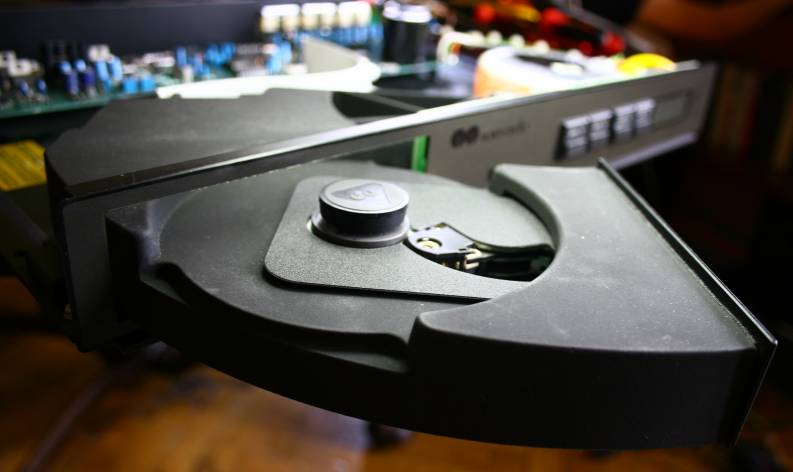
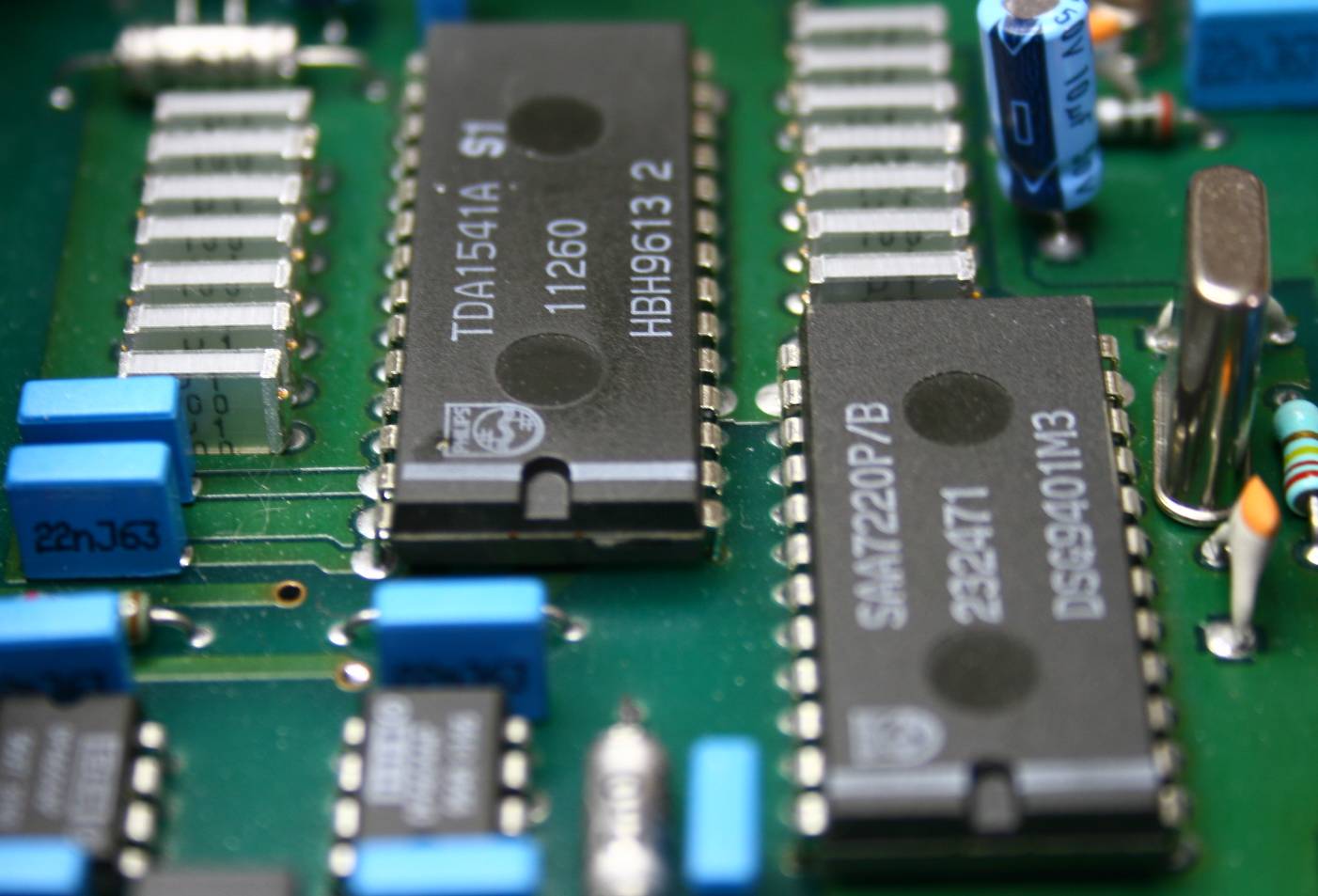

The red lines
are TRACE CUTS and the yellow cables are signal bridges. That's all !!
Below is the
Marantz CD94 MK2 modification to NOS
(remember
- it has 2 DAC
chips in mirror signal mode)
The circuitry which we must
modify is on the vertical brown PCB on the
right hand side of the player. Actually after removal - the
underside is green.
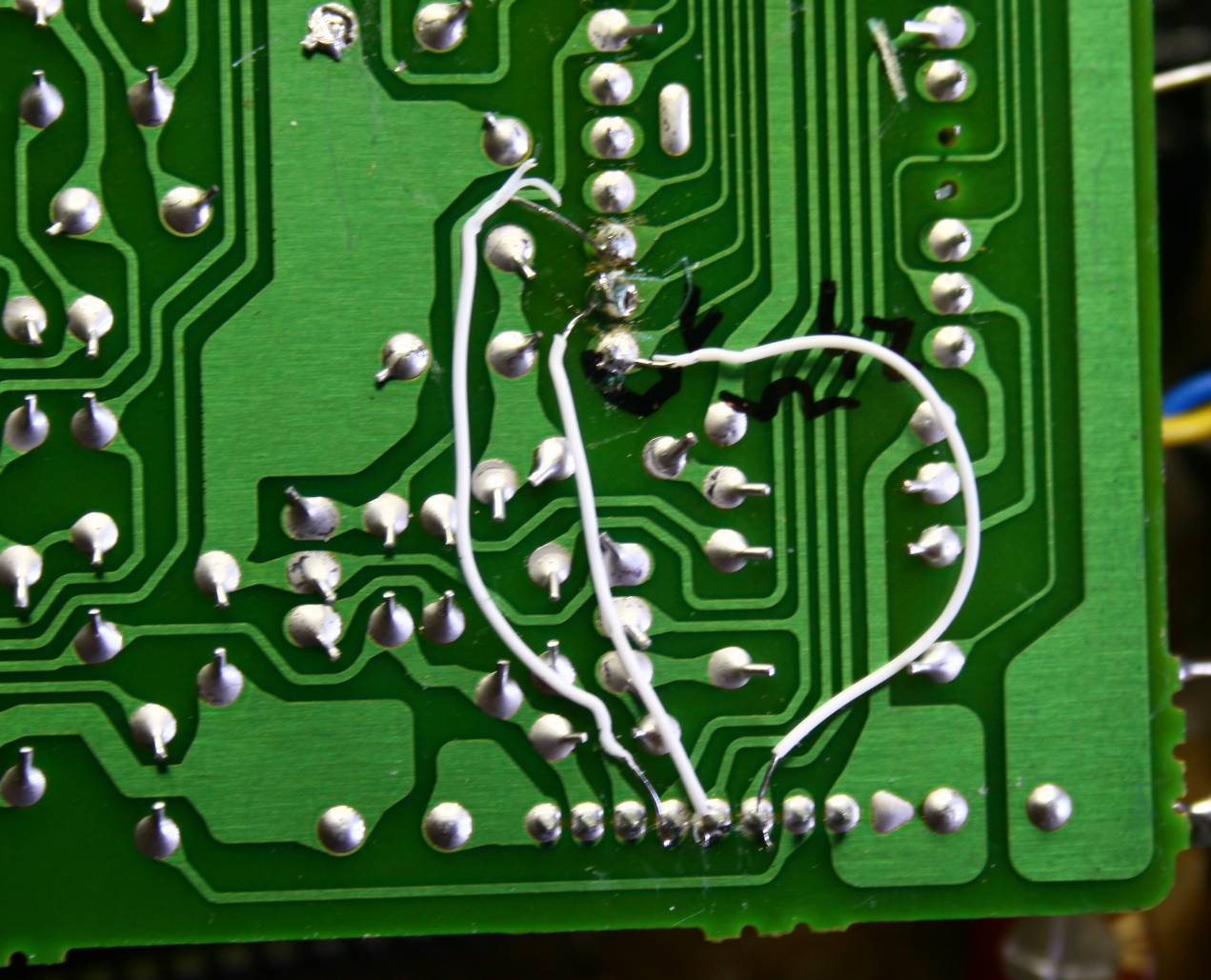
AND NOW ABOUT NOS for TDA1540
?????
another
worthwhile thing to do.
There are so many wonderful players with TDA1540 - the digitally
inferior and musically superior DAC.
Like for example Revox 225, Marantz 73, Loewe CD9000, tens of Grundigs,
Philipses, Nakamichi, and many many more.
I am trying this on my Philips
CD-104
Recommendation
courtesy of Frank Willem de Haan
from the Netherlands whom I thank
- remove TDA7030
completely
- in place of
TDA7030 connect four wire bridges:
pin 20 - pin 3
pin 17 - pin 10
pin 18 - pin 6
pin 21 - pin 7
- de-solder only pin 16 on SAA7000
with a solder wick and make
sure pin 16 "floats", it does not make any contact the circuit board.
(or simply cut the trace)
- solder a 1K
resistor on top of SAA7000, between pin 16 and pin 18
(to put SAA7000 in 14 bit mode, because TDA1540 needs 14 bit)
Listen to your
CD104 the way the Philips engineers designed the CD
player, before they were forced into messing up the sound with
oversampling because of the "16 bit race".
Non destructive,
if you want to revert; remove 4 wires, solder TDA7030
back in place, remove resistor and re-solder SAA7000 pin 16.
[While you are
at it with the CD104, remove the "griplets" (small
rivets) between top and bottom of the circuit board and replace each
one by
soldering a piece of wire from top to bottom for better
earthing. This is the best advice given to me and has solved almost
every problem with the 12 CD 104's that I have stashed around the house]
I tried this recipe
on Philips
CD104 and
Revox B225 and in both cases the improvement is huge.
Very much recommended !
Simple, innit ?
NOS for the SONY
CDX1088 digital filter
The Sony players
like CDP-555ESD , and some others like Nakamichi
CDP2-e do
not use the SAA7220p/B but instead they use Sony CDX1088
chip.
It basically
works the same as the Philips, but it is SMD hence it is
hard to solder to its legs.
The CDP-555ESD
has 4
times oversampling applied inside the chip that precedes the Philips
DAC
TDA1541, which is SONY CXD1088. We can identify the pins which carry
I2S signals and bypass the chip by means of a bridge of 3 wires a'la
Philips
7220p/B. BUT..... the sony chip is so small and it is SMD that the
soldering is too difficult for me. Even with 10 x magnifying glass and
a sharp soldering tip I am unable to do it properly.
The tracks leading to and fro this SONY 1088 chip have no other points
where I could tap to them. The only possible scenario is to solder to
chip legs.
I threw the towel. Sorry. Maybe I will try one day again.
A month later I
decided to try
it. I chose Sony CDP333ESD and I bridged the I2S signal over the
CXD1088 . The result was a mixed bag - there was sound audible only at
MAX amplifier volume. So the player played OK, but it was somehow
muted. I found 3 different MUTE pins on three chips around. I
experimented with isolating, floating, grounding of these pins - and no
success. The music was audible but probably -60dB. I gave up until
someone tells me where I went wrong.
November
2008
Sensational breakthrough application of NOS
to Sony
Thanks to the
power of internet, I got some help from very kind pen pal
Mr. Avinash. He suggested a digital trick which basically changes the
internal data protocol between SONY chips which preceded the TDA1541
DAC.
Here is what he
says:
I
thought I would let you know that I
have now successfully made the NOS mod to the Sony CPD 227ESD. (L.F.
> It is also directly applicable to Sony 950, 710, 337ESD, 333ESD
ESD, 555 ESD, and probably also to the Nakamichi CDP-2e)
The
main issue to solve is that the output of the Sony DSP chip CXD1125 is
in the Sony/EIAJ format and not the Philips I2S format. The easiest way
to convert the Sony format to the I2S format is to delay the LRCLK
signal by 7 bit clock pulses and swap the analogue outputs of the
TDA1541A so that what was previously the Left channel ouput becomes the
Right channel and vice versa. BCK and DATA can simply bypass the
CXD1144P filter chip.
I
used a 8 bit serial in, parallel
out (SIPO)
shift register (74HC164A) chip which costs about 20p in the UK. The
input to the chip is the LRCLK signal from the CXD1125 chip and I used
the 7th bit as output to the two TDA1541A's. You also have to take a
parallel BCK signal to this chip as well as +5V (taken from the
CXD1125) and ground. If you take a look at the data sheet, copy
attached, you will be able to see how it works.
This
gives full volume (and full
resolution) on the analogue outputs of the TDA1541A.
I
was getting some noise when the CD player was not playing any CD's but
this goes away if you switch the Digital Out at the back of the CD
player off.
The
sound out is analogue like and
flowing very much
like other NOSed TDA1541A CD players but the 227ESD also appears to
have better resolution and clarity. It is a little bit better then my
NOSed Marantz CD40 to my ears.
I
am listening to it right now and it
is sounding very good!!!
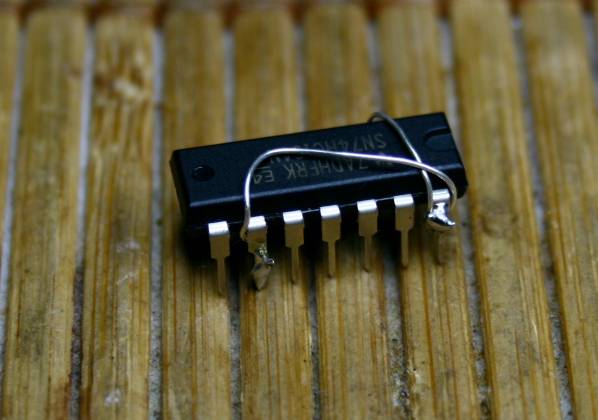
On the photo
above the pins 14, 9 and 2 are shorted, ready for +5V
The
pin connections I used on the
74HC164A are:
Pin
1 - LRCLK from CXD1125 taken from
before R540 connection with R540 leg lifted - input clock
Pins
2,9,14 - +5V from Pin 8 of
CXD1144P supply line
Pin
7 - Ground
Pin
8 - BCLK from before R542 with
R542 leg lifted.. Same signal goes to both TDA chips leg 2 and 2.
Pin
12 - Output LRCLK to the
TDA1541A's legs 1 and 1 parallel. - left-right switch clock
The remaining DATA signal goes from any of the R541 sides of
resistor to both legs 3 of TDA1541 paralleled,
All other pins of the 74HC164A are unused.
This already plays FANTASTIC music but makes some noises on pause.
From
Lukasz:
CDP227ESD has
all points of interests exposed on upper side of PCB.
We have the
BEFORE FILTER points where the digital signal must be
captured: Resistors R540, R541, R542 carry data, BCLK and LRCLK
signals.
AFTER FILTER
there are elements that must be lifted: R553, 555, 556 and
557. L555 (coil in a black box)). I broke them irreversibly by pliers.
DATA goes
directly across the FILTER chip. LRCLK goes by means of the
new chip 74HC164A which shifts it. BCLK goes across the filter to DAC
but on its way it touches 74HC chip pin 8. TDA as usual is operated
with legs 1, 2 3 and 4 floated but 2 and 4 are connected. Both DACS are
parallel - all respective inputs shorted.
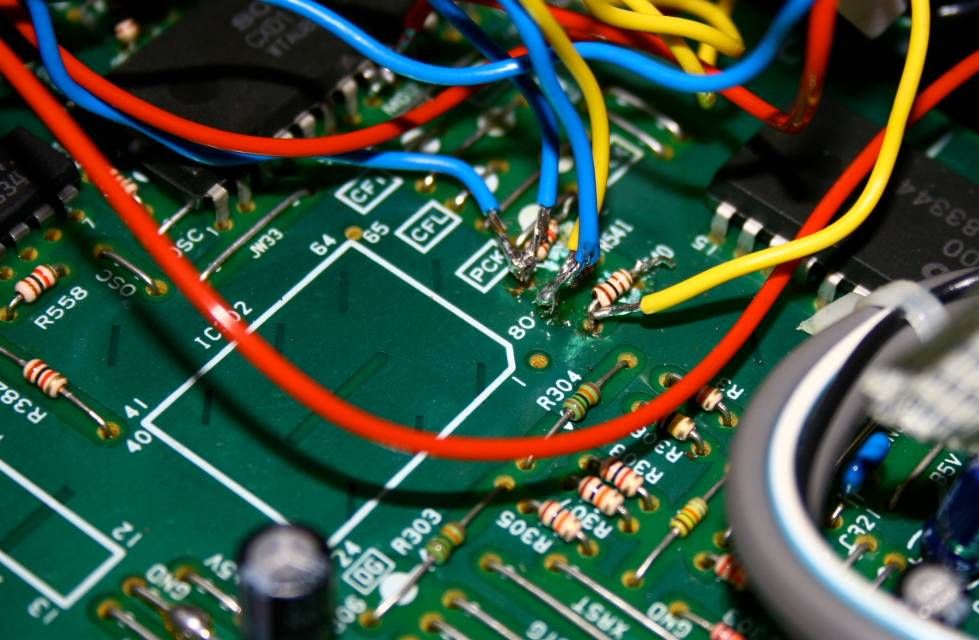
There
will be garbage noise when CD
is on pause or skipped to next
track.
The mute remedy is analog relay mute which used to mute the old signal.
We must find the output relay - the black box near old RCA outputs. We
connect the relay's legs marked NO to the RCA outputs.
Before that we must float these relay legs which used to go to old
outputs. During mute period the relays will ground the signal.
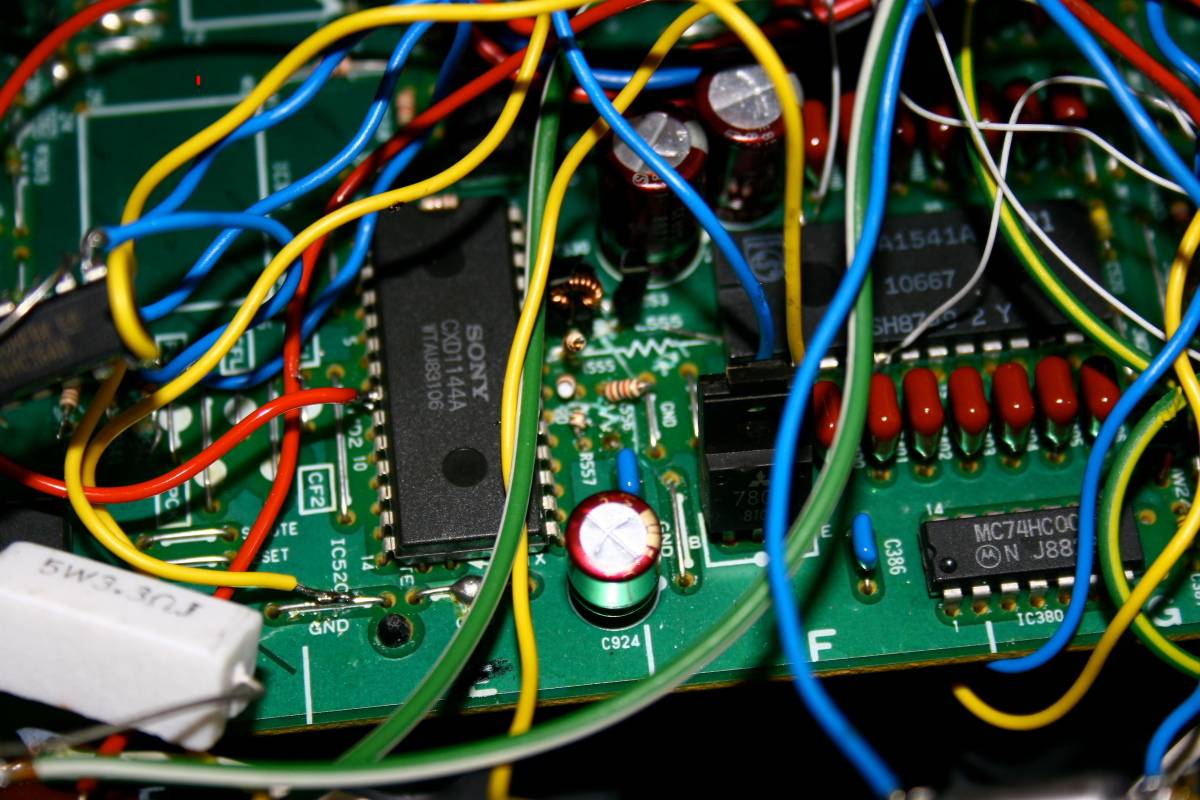
Above you
see the resistors leading to the two DACS lifted
(huh, to be precise - they are broken. I admit it. My tricks are
irreversible.)

The small black
cube MATSUSHITA in the center of the photo is the
output muting relay.
The mute works well for no play period, for play period, for fast
forward and backward too. Only for the track skip there will be 1/10 th
of a second of unwanted signal. Small problem for a great improvement
overall.
The sound does improve a LOT. It jumps to the next upper class of
playback systems.
Strongly recommended.
In Sony CDP-333ESD with one TDA and CXD1125 demodulator and typical
digital filter CXD1088
we go like this: the whole job is done on the bottom of the PCB.
data goes straight from CCD1125 leg 78 (lift R311) to TDA pin 3
(floated)
BCLK goes from pin 76 of the 1125 (trace it to the first breaking point
- a jumper or resistor and then float it by lifting that part) to
the pin 8 of the 74HC and from there straight to TDA pin 2
(joined with 4 and together - floated)
LRCK goes from pin 80 of the
1125 (trace it to the first breaking point - a jumper or resistor and
then float it by lifting that part) to the pin 1 of the 74HC and
from pin 12 (output of 74HC) to TDA pin 1 floated.
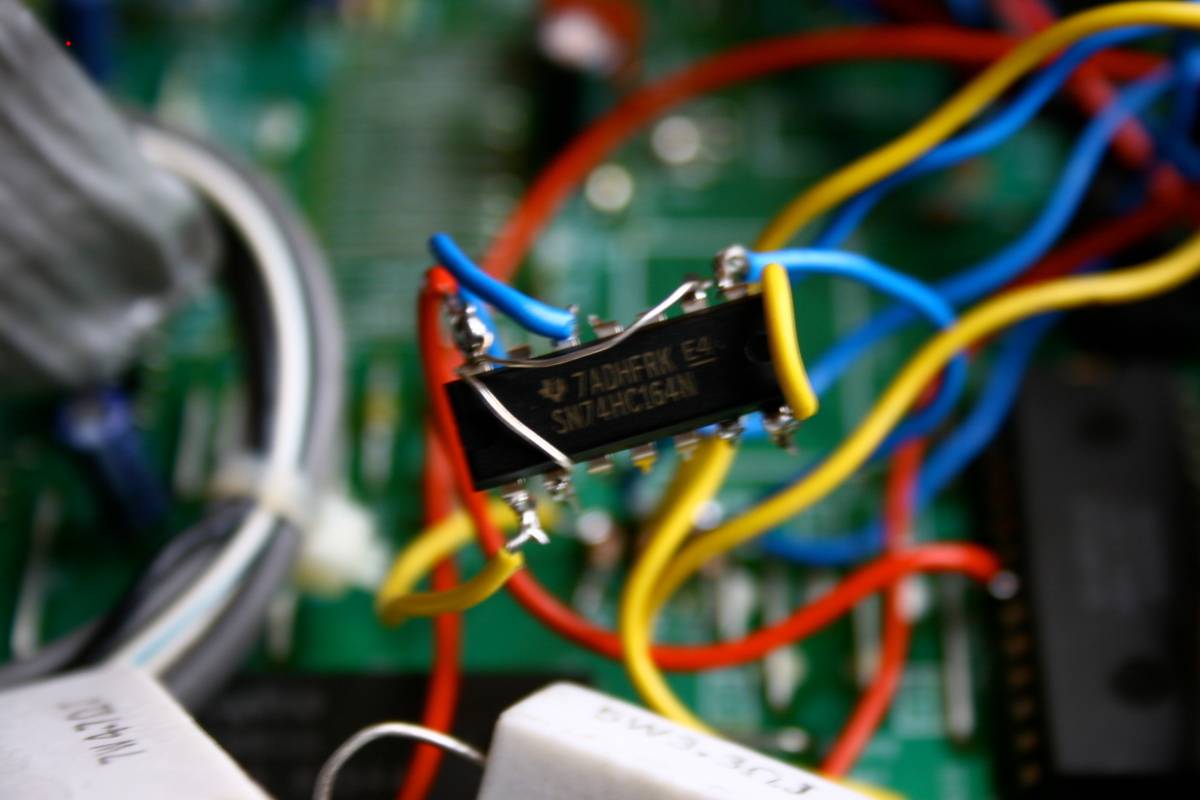
ABOVE: The 74HC chip in first experimental player 333 ESD. Works from
the first time !!!
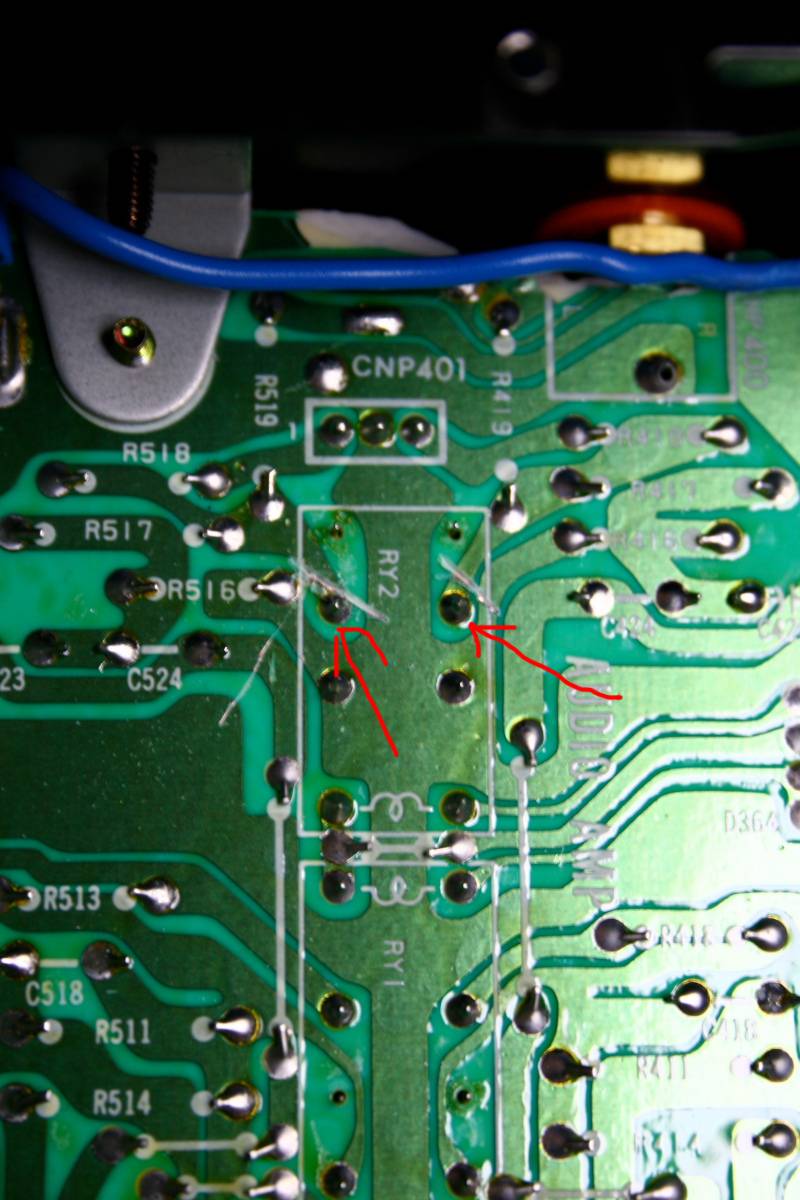
These are output muting relays to be used in 333ESD
They are already floated.
FROM THE DATASHEET:
MC74HC164AD -
8-Bit Serial-Input/Parallel-Output Shift Register
High–Performance
Silicon–Gate CMOS
The MC74HC164A is identical in pinout to the LS164. The device inputs
are compatible with standard CMOS outputs; with pullup
resistors, they are compatible with LSTTL outputs. The MC74HC164A is an
8–bit, serial–input to parallel–output shift
register. Two serial data inputs, A1 and A2, are provided so that one
input may be used as a data enable. Data is entered on each rising edge
of the clock. The active–low asynchronous Reset overrides the Clock and
Serial Data inputs.
• Output Drive Capability: 10 LSTTL Loads
• Outputs Directly Interface to CMOS, NMOS, and TTL
• Operating Voltage Range: 2 to 6 V
• Low Input Current: 1 mA
• High Noise Immunity Characteristic of CMOS Devices
• In Compliance with the Requirements Defined by JEDEC Standard
No. 7A
• Chip Complexity: 244 FETs or 61 Equivalent Gates

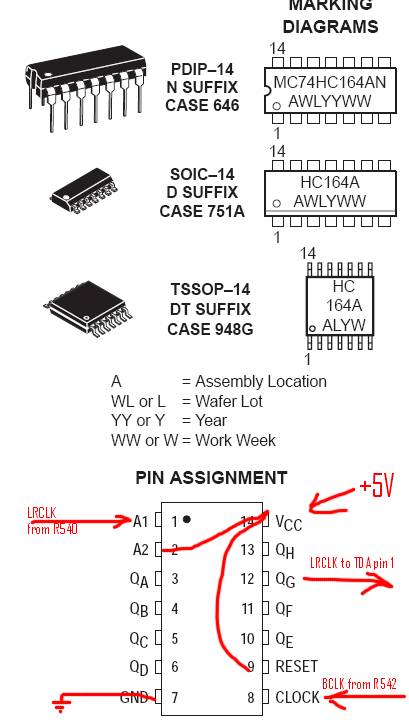
DATASHEET:
http://pdf1.alldatasheet.com/datasheet-pdf/view/12165/ONSEMI/MC74HC164AD.html
SONY family of ESD
players in Non Oversampling mode (NOS)
after
experimenting with my two players from that family - namely
CDP227ESD and CDP333ESD I drew a conclusion.
1. TDA1541A is a
hell of a dac, its full potential is unlimited.
2. The Sony NOS
implementation is better than Philips one, to be found
in Grundigs, Marantzes and Philipses. The difference must lie either in
the laser mechanisms (227 uses KSS151A and 333 uses a better (best)
KSS190A or BU1. Or it lies in the fantastic sony demodulator chip -
the one which converts laser impulses into proper digital format
datastream. Or the difference is a sum of the two above. Anyhow - the
sound coming from NOSed and lampized ESD players is totally awesome.
3. Two DAc chips
in 227 do sound better than one in 333.
4. 6N2P is best
tube I know today for this particular application (in
SRPP mode)
5. if you love
MUSIC not HiFi - you can not find anything better
without financial constraints. I guarantee it.
It is very very
hard to impress me with all my experience and
knowledge, I was not prepared that there may be such a giant quality
leap waiting to be unleashed.
Even SATCH dac,
which theoretically is TDA at the limits - is inferior
to Sony in NOS mode. That is understandable - SATCH must use SP/DIF
process of transmission, and Sony is one box solution which does
without SP/DIF at all. All process is direct and very simplified.
As good as Sony
227ESD is on its own, as great as it is with
lampizator, after NOS - the sound is drop dead gorgeous. It re-defines
my quality ladder, all classifications of sound quality must be
downgraded to make room for this new whole class of quality.
The pleasure of
listening goes up whole level, the amount of
information is beyond my wildest expectations. It is not about bass or
trebles, it is about the ease of understanding what is in the
recording. The details in background become so easily understandable,
the secondary instruments are miked anew. I hate to say the most
trivial sentence like "I heard things I never heard before" but that is
just that - all intimately known recordings become totally new
experience. On general note, all aspects of reproduction become very
LOVABLE and right - timbre, color, space, timing, voices are natural,
space is wiiiiidddeee, instruments clear, separated, audible. I cant
really describe it. It is far above my language skills to tell you how
good sound becomes.
From everything
I ever heard, the 227 ESD nosed is by far the best
sound. This is so good that I would say it is the end of the road.
Absolute lack of desire to try improvements. It is what I dreamed about
all my life. I cant even write about it anymore - I rest my case.
NOS for
Grundig Fine
Arts CD9009
read
here at the bottom of the page.
GOOD LINK to
read
GOOD LUCK AND
GOOD NIGHT
BACK










